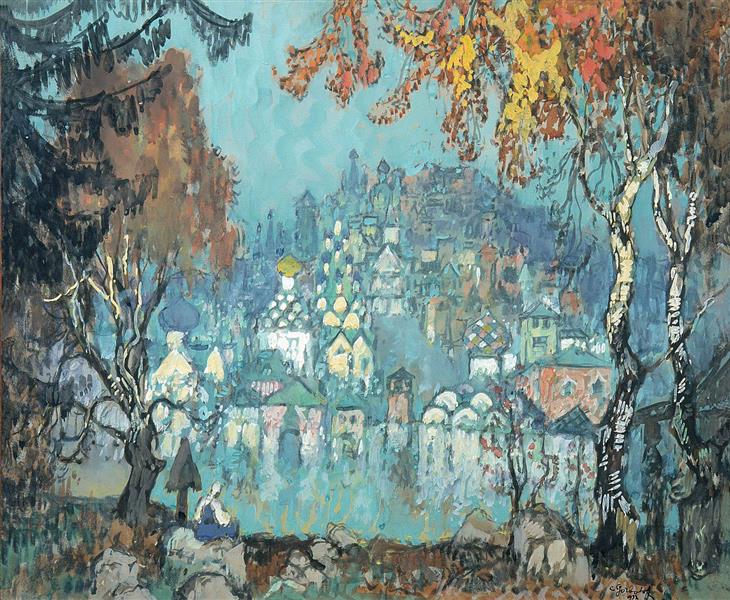Description
When observing the painting "Ciudad drowned (Kitezh)" of 1933, created by Konstantin Gorbatov, we immerse ourselves in a landscape that transcends the mere physical representation to enter into the field of mythological. The work, clearly inspired by the legend of the invisible city of Kitezh, embodies the mixture of mysticism and reality that characterizes a lot of Russian art of the early twentieth century.
Gorbatov's painting is revealed as a delicate balance of natural and architectural elements. In the center of the composition the golden domes and the constructions of a lost city, barely visible in the vast water extension that surround them. These buildings, crowned by orthodox crosses, allude to the rich religious and cultural substrate of the prerevolutionary Russia. The city seems to be partially submerged, which hints at a catastrophe and divinity narrative, in line with the Kitezh legend, which is said to disappeared under the waters to avoid being desecrated by invaders.
The use of color in this work is particularly remarkable. The predominantly cold tones of the blue and gray dominate the scene, evoking an atmosphere of mystery and serenity. These colors contrast with the golden reflexes of the domes and the warm lights that seem to emanate from some windows, suggesting a latent, protected and secret life, within the submerged city. Gorbatov also uses touches of green in the vegetation that floats and rests on the water, which adds a dimension of hope and rebirth to the scene.
The sky in the painting presents a rich range of shades ranging from the deep blue to the pink and gold of sunset, which amplifies the feeling of unreality and dream. This stylistic decision strengthens the duality between the tangible and the ethereal, inviting the viewer to contemplate the work beyond its pictorial surface and to explore its symbolic and emotional burden.
Konstantin Gorbatov, known for his ability to capture romantic landscapes and urban scenes, brings to this work a sensitivity that resonates with his artistic training and trajectory in the Russian Empire and later in Europe. Formed in the Imperial Academy of Arts in St. Petersburg, Gorbatov was deeply influenced by symbolism and artistic currents that explored the spiritual and the mystical.
In "Ciudad drowned (Kitezh)", Gorbatov not only stands out for its technical skill, but also for its ability to infuse painting with an implicit narrative. This approach reflects a tradition of Russian narrative painting, where art serves as a gateway to stories and legends deeply rooted in national culture.
Through this work, Gorbatov offers us not only a window to a mythical field, but also a reflection on the fragility and resistance of culture and spirituality to adversities. The "drowned city" thus becomes an emblem of the perennial struggle to preserve identity and memory in the midst of change and destruction, a relevant meditation in any historical context.
In conclusion, "Kitezh)" of Konstantin Gorbatov is a poetic and visual evocation that transcends his own time, inviting the viewer to immerse himself in the legend and to reflect on the enduring power of myth and memory.
KUADROS ©, a famous paint on your wall.
Hand-made oil painting reproductions, with the quality of professional artists and the distinctive seal of KUADROS ©.
Art reproduction service with satisfaction guarantee. If you are not completely satisfied with the replica of your painting, we refund your money 100%.

